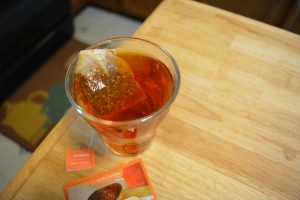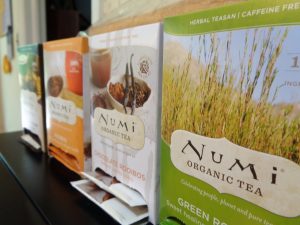To Tea, or Not to Tea: That Is the Question.
I had a carefully-considered schedule planned for these 21 days. We’d start by exploring the possibilities that black teas have to offer, move on to green and white, and then we’d hit some herbals. But it’s Day 8 now, and I’m giving myself freedom to deviate. Stay with me & I’ll make sure you don’t get lost.
So, what’s the big deal–how is this such a detour?
Okay, so remember that black, green, and white teas all come from the same plant: Camellia sinensis, also known as the Tea Plant. Any brew that comes from this plant is called tea. Here in the U.S. we tend to call any plant that’s brewed in hot water (besides coffee) tea. In actuality, though, only brews from Camellia sinensis are technically tea.

Tea plant (Camellia sinensis) from Köhler’s Medicinal Plants, 1897
A hot water brew, or infusion, from any other plant is more accurately called tisane. Our chamomile, mint, and lavender “teas” are really all tisanes, and, in general, tisanes tend to be caffeine-free while teas are caffeinated. So, even though we prepare tisane infusions in the same way as we do tea, the only true teas are those that come from C. sinensis. That said, we’re not going to get too caught up in semantics in this series.
[Incidentally, Alabama folks should find the Camellia genus familiar, because it’s cousin, the Japanese-native Camellia japonica, is our state flower. Our camellia is only ornamental, though, not used for tea.]
Anyway, while there’s certainly more to visit on our Camellia sinensis tour, and we’ll get back on track eventually, today we drink rooibos, which I’ve already mentioned a time or two in passing this series.
Rooibos

South Africa

The Cederberg Municipality of South Africa
Often mistaken for black tea, rooibos is also called red tea, bush tea, and red bush tea. The herb is indigenous and endemic (meaning it doesn’t grow anywhere else) to the Cederberg region of South Africa.
Rooibos is earthy and robust, and it’s another of those really aromatic brews whose distinct scent that not everyone will find appealing. If you sip past the initial aroma, however, you’ll note a mildly vanilla flavour that tastes good on its own but also pairs well with any sweetener and/or milk you’d want to add. Like most tisanes, it’s also caffeine-free! In fact, it’s the perfect nighttime brew because it’s so calming it actually induces sleep. Indigenous African traditions as well as some more recent scientific studies suggest that the herb has medicinal qualities that can, among other uses, help our livers detox. All I can say is that I feel great (and very sleeeeeepy) after drinking it. Brew it for 4-7 minutes, drink it plain, add honey, or dress it up as you would tea.

Adding a dash of vanilla extract, along with milk and sugar (or a natural vanilla creamer) really accentuates the vanilla undertones of rooibos.

Notice the orangy-red colour–it’s no wonder people often think this is a black tea.
As I mentioned on Day 6, I had a really hard time finding this tisane in my local shops at first, so I ordered online on Numi’s website. But in the last two weeks I’ve seen boxes of rooibos at both my local Walmart and Publix, so you should be able to get your hands on some more easily than I did.
I have to highlight Numi as a company again, because not only do they work towards being ecologically sustainable, but they have also established sustainable relationships with the rooibos farmers in South Africa who harvest the plant. According to their packaging, they’ve worked with the same organic rooibos farmers since 1999. That’s really great for a number of reasons not the least of which is that rooibos is a huge part of this region’s economy.

There are several rooibos varieties–we’ll likely sample them all this week.
While the industry is currently booming, there is some potentially not-so-great-news on the horizon–with climate change, there’s no telling what it will look like in the future. But for now you can feel good that your rooibos purchase is helping to keep those 4,500+ jobs intact.
Have you tried rooibos? What did you think?


May 8, 2018 at 6:59 pm
Rooibos is hands down one of my top teas! As I am learning here, I should probably say top tisanes. I drank it everyday when I was in South Africa, many days I drank it 2 and 3 times.
May 11, 2018 at 2:33 pm
That’s so cool! Is it a common household beverage there? I couldn’t get the sense in my research if it is actually popular there! I’d love to learn more (and maybe one day visit!)